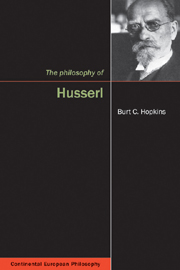Book contents
- Frontmatter
- Contents
- Acknowledgements
- Abbreviations
- Prolegomenon: Husserl's turn to history and pure phenomenology
- I Plato's and Aristotle's theory of eidē
- II From descriptive psychology to transcendentally pure phenomenology
- III From the phenomenology of transcendental consciousness to that of monadological intersubjectivity
- IV From monadological intersubjectivity to the historical a priori constitutive of all meaning
- V The unwarranted historical presuppositions guiding the fundamental ontological and deconstructive criticisms of transcendental philosophy
- 16 The methodological presupposition of the ontico-ontological critique of intentionality: Plato's Socratic seeing of the eidē
- 17 The mereological presupposition of fundamental ontology: that Being as a whole has a meaning overall
- 18 The presupposition behind the proto-deconstructive critique of intentional historicity: the conflation of intrasubjective and intersubjective idealities
- 19 The presupposition behind the deconstruction of phenomenology: the subordination of being to speech
- Epilogue: Transcendental-phenomenological criticism of the criticism of phenomenological cognition
- Coda: Phenomenological self-responsibility and the singularity of transcendental philosophy
- Notes
- Bibliography
- Index
16 - The methodological presupposition of the ontico-ontological critique of intentionality: Plato's Socratic seeing of the eidē
from V - The unwarranted historical presuppositions guiding the fundamental ontological and deconstructive criticisms of transcendental philosophy
- Frontmatter
- Contents
- Acknowledgements
- Abbreviations
- Prolegomenon: Husserl's turn to history and pure phenomenology
- I Plato's and Aristotle's theory of eidē
- II From descriptive psychology to transcendentally pure phenomenology
- III From the phenomenology of transcendental consciousness to that of monadological intersubjectivity
- IV From monadological intersubjectivity to the historical a priori constitutive of all meaning
- V The unwarranted historical presuppositions guiding the fundamental ontological and deconstructive criticisms of transcendental philosophy
- 16 The methodological presupposition of the ontico-ontological critique of intentionality: Plato's Socratic seeing of the eidē
- 17 The mereological presupposition of fundamental ontology: that Being as a whole has a meaning overall
- 18 The presupposition behind the proto-deconstructive critique of intentional historicity: the conflation of intrasubjective and intersubjective idealities
- 19 The presupposition behind the deconstruction of phenomenology: the subordination of being to speech
- Epilogue: Transcendental-phenomenological criticism of the criticism of phenomenological cognition
- Coda: Phenomenological self-responsibility and the singularity of transcendental philosophy
- Notes
- Bibliography
- Index
Summary
Heidegger's critique of Husserl's formulation of phenomenology takes its bearings from both the last phase of the first stage of its development and from the entirety of its second stage. Heidegger presents his critique as stemming from phenomenology's most basic principle, the “return to the things themselves”, and thus as a “phenomenological” critique. As such, his critique purports to be an immanent critique, in the precise sense that it claims to show that when taken on its own terms as a phenomenology guided by the principle of philosophical radicalism, Husserl's formulation of phenomenology falls short of its stated intention. Heidegger's critique has interrelated ontological and methodological foci. The former challenges Husserl's claim that intentionality is the most basic phenomenon of phenomenology; the latter challenges the capacity of not just Husserl's but of any reflective and eidetic method to encounter the source of the meaning of Being that is presupposed by the mode of access to phenomena made possible by this method.
Heidegger's ontological critique has in turn two interrelated moments. The first claims that the “being characters” (Seinscharactere) of the entity that exhibits intentionality as an essential structure are not originally secured by Husserl. The second claims that the “meaning of Being” that guides Husserl's formulation of intentionality in terms of the “immanent” being of the intentio and the “transcendent” being of the intentum is attained by going back not to the matters themselves proper to the entity that has the structure of intentionality but to a traditional idea of philosophy.
- Type
- Chapter
- Information
- The Philosophy of Husserl , pp. 216 - 231Publisher: Acumen PublishingPrint publication year: 2010



